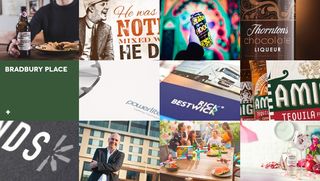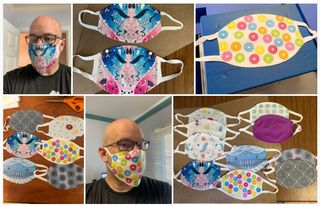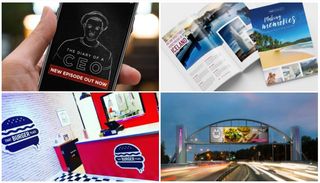The UK is in recession for the first time in 11 years, and other countries aren’t doing much better. But it’s not all doom and gloom. Without sounding callous, plenty of creatives have done very well for themselves in recessions past, and there’s no reason why you can’t do the same in 2020-2021, even during the peculiar circumstances that have led to this particular slump.
In this post, we meet creatives who’ve made bold moves to advance their careers in 2020. And we point to some lessons they can offer the rest of us.
01. Be brave and move jobs

In the midst of a recession, leaving an existing job can seem pretty scary. That’s exactly how Amy Kilner felt when she left her agency this month to join independent drinks company Global Brands’s in-house studio Clay Creative as a digital content producer.
“I was definitely worried that making a career move during a global pandemic might backfire,” says Amy, best known for her blog and Instagram account thedesignfix. “So I had been planning to power on through with my previous role. But then I saw, on a popular jobs website, an opportunity to join the biggest drinks company up North. I knew it was the perfect next step for me. I'd been thinking about moving into a more specialised role within digital content creation for a while, plus it meant I could work with people locally again, even if would mostly be remotely.”
It’s an approach that’s at least worth considering yourself. After all, recession or no recession, your only have one life, and if you don’t seek opportunities to find your perfect job, you’re going to end up disappointed.
So be brave, be proactive, and put yourself out there. Also, maximise your chances of winning your dream role by following our interview tips and exploring our inspirational design portfolios.
02. Choose your employer wisely
While we’d never dissuade you from following your dreams, you do also have to be practical. And in a recession you have to ask yourself: is this company likely to survive?
Get the Creative Bloq Newsletter
Daily design news, reviews, how-tos and more, as picked by the editors.
To answer that question, you need to do your research, and also trust your gut feel about the employer based on their communications and dealings with you. Remember, you’re interviewing them just as much as they’re interviewing you.
In Kilner’s case, the signs looked good. “My new employer owns brands such as VK, Hooch, Franklin & Sons and All Shook Up Cocktails,” she explains. “Due to Covid, they’ve also opened up a new ecommerce website called Good Time In so that you can order drinks straight to your door. Even though the world is a bit upside-down at the moment, the fact these guys were adapting so well was a really good sign, and something I wanted to be a part of.”
03. Power through your probation

Getting a job in a recession can be tough, but starting it can also be a challenge. Most jobs have a probationary period where the employer assesses whether you’re right for the role. And while that's largely a paper exercise, in a recession it can be a little unnerving to know that something might in theory go wrong.
In the case of frontend UI developer and designer Kam Banwait, who began a new job this March at Janes.com, this was complicated by the sudden move to remote working that affected everyone in the sector. “Starting the new job was the scariest part,” he recalls. “This was the beginning of lockdown, and I was working from home at the time, as was everyone else at the company.” Based on his experience, his advice to others applying for a new role is: “Be open about your concerns and ask loads of (relevant) questions to the recruiter, or your to-be-boss, about how things are going to work”.
Essentially, that’s good advice to follow throughout your probationary period too. You won’t know whether your manager is happy with your performance unless you keep checking in and getting a measure of how things are going from their perspective. They in turn will appreciate your keenness, and it’s a great way to nip any potential problems or misunderstandings in the bud.
04. Be adaptable
culture is lying to us… but we’re onto it, and we’ve got you. pic.twitter.com/Up5v0s39PLSeptember 12, 2020
In recessions, demand for certain specialised skills may drop dramatically. So it’s important to stay adaptable, and open to upskilling if necessary. Naomi Soneye-Thomas, a filmmaker at Napier Films, offers a great example.
“At the start of lockdown, like many others working in the creative industries, I lost a lot of my work,” she says. “Although many people working in animation still had work, those of us who go out and film things live were stuck. So, I thought upskilling could be useful. I'd always been interested in learning animation so I decided to start learning Blender (see our Blender tutorials). And it worked out well for me. In fact, I ended up using some of those skills in our biggest job to date, creating animation, video and graphic design for tiata fahodzi, a black theatre company that focuses on stories of the African diaspora in the UK.”
Soneye-Thomas connected with tiata fahodzi through Twitter, after their CEO and artistic director Natalie put a call out, looking for a content creator to work with. “In many ways it felt like a chance encounter that we were able to connect like that, given that I'd been learning the relevant skills to complete the job,” Soneye-Thomas says.
She went on to create some 3D graphics for tiata fahodzi, as well as a short animation calling for better representation of black people on stage (above). “I’d written and directed animations as a filmmaker, but had never made one for a company before, so being able to adapt in this way was very helpful,” she says. “Even though we've been out and about filming again now lockdown has eased, being able to angle myself more towards animation gave me a better chance of securing work while we couldn’t.”
05. Ask for help
In ‘normal times’ (remember those?), it might have seemed like a bad look to send out begging messages on social media when you’re out of work. But these are not normal times, and even some of the most experienced and accomplished freelancers have been left out in the cold… so right now, we’d say just go for it.
Designer and illustrator John Harman did just that after his company lost a ton of work in April, and he was among the 20 per cent of employees who were furloughed. “Not knowing how long the furlough would be in place, I immediately went to my social media and sent out a blanket ‘Help! I need work!’ message,” he explains.
“Within an hour I'd gotten a message from a former CEO of mine, who'd come out of retirement to be the CTO at a local tech startup.” While Han was initially only offered part-time work, by August he’d been offered the role of director of design operations, a big step up from his previous role.
06. Create your own opportunities

When you need a new job or new freelance clients, the most proactive thing you can do is chase companies directly. But in a recession you’re likely to get blanked a lot, and may have to be patient. In the meantime, it’s also worth pursuing the indirect route: making a name for yourself through personal side projects.
When John Harman first looked for freelance work a few years ago, he says, he struggled to find anyone willing to give him a chance. “So what I started doing at that time was short design explorations and daily challenges, to drive traffic to my social media and site. This landed me a few design opportunities from people seeing what I was creating each day.”
It’s a lesson he continues to follow. And in 2020, in between being furloughed and getting his new role, he helped set up Creative Being, a new project to help support fellow creatives.
“I was discussing an idea with a few members of the Illustrator on iPad beta community about ways we could build a program to support the greater creative community, by selling masks featuring artwork from the members,” he explains. Having secured funding from Adobe’s Creative Residency Community Fund, that project is now up and running: you can read more about it here.
To get further inspiration for your own hustles, check out our guide to better side projects and ways to make money from home as a creative.
07. Harness the community
As Kilner points out, the creative community is generally helpful and friendly, so make the most of it. “Stay active online and speak to other designers to see how they are getting on,” she urges. “There's an amazing creative community that’s so supportive. I've spoken to so many inspirational creatives through Instagram and Twitter, and that can really make a difference when you are feeling a bit lost or uninspired.”
She adds, “Keep in touch with your clients but don't be afraid of trying something new, or changing the path you thought was the right one. Sometimes it's the best way to learn where you're meant to go in life! Design and marketing are so important right now to help save businesses, so the work is there. You just have to go for it. Every no is a step closer to a yes.”
08. Be persistent

Our final piece of advice is to be persistent, and don’t let rejection get you down. In a recession, it’s inevitable you’ll get more knockbacks than in normal times, however talented you are. But you will get there in the end.
Graphic designer Jonathan Hall offers a real-life example. He was furloughed at the start of lockdown but working in the travel industry, he was realistic about his chances of returning to work full-time. So he’s spent the weeks and months since March applying for jobs, and had quite a frustrating time of it.
“There weren't many design jobs out there around the first half of furlough and it was slim pickings in terms of suitable roles for me,” he explains. “As I set about emailing agencies, some answered and were understanding of my situation, but some didn't reply even after chasing. I realise there are some arrogant people in this industry who won't give you the time of day, which is disheartening when you're looking for any bit of help you can get.”
As offices started to open again and workforces got a bit back to normal, more design jobs started becoming available. “Recruiters were in touch and I had a couple of interviews. I have a love/hate relationship with recruiters. A few genuinely care about your progression and want to find you a job. Some you have limited interaction with, and it can be like getting blood out of a stone. And most act like they're your friend: you exchange a couple of emails and get your hopes up, only to never hear from them again.”
Finally, in September his company announced impending redundancies. “But as I was on a call with my line manager, who was letting me know my role was at risk, I took another call from a guy I'd had two phone interviews with and done a task for. And he offered me a job. Unbelievable! I was technically out of work for about two minutes. I'd gone from being made redundant to getting myself a better-paid job at a children's charity where I'd be working from home, with view to being a senior designer further down the line. What a stroke of luck!”
Read more:

Thank you for reading 5 articles this month* Join now for unlimited access
Enjoy your first month for just £1 / $1 / €1
*Read 5 free articles per month without a subscription

Join now for unlimited access
Try first month for just £1 / $1 / €1
Tom May is an award-winning journalist and editor specialising in design, photography and technology. Author of the Amazon #1 bestseller Great TED Talks: Creativity, published by Pavilion Books, Tom was previously editor of Professional Photography magazine, associate editor at Creative Bloq, and deputy editor at net magazine. Today, he is a regular contributor to Creative Bloq and its sister sites Digital Camera World, T3.com and Tech Radar. He also writes for Creative Boom and works on content marketing projects.
